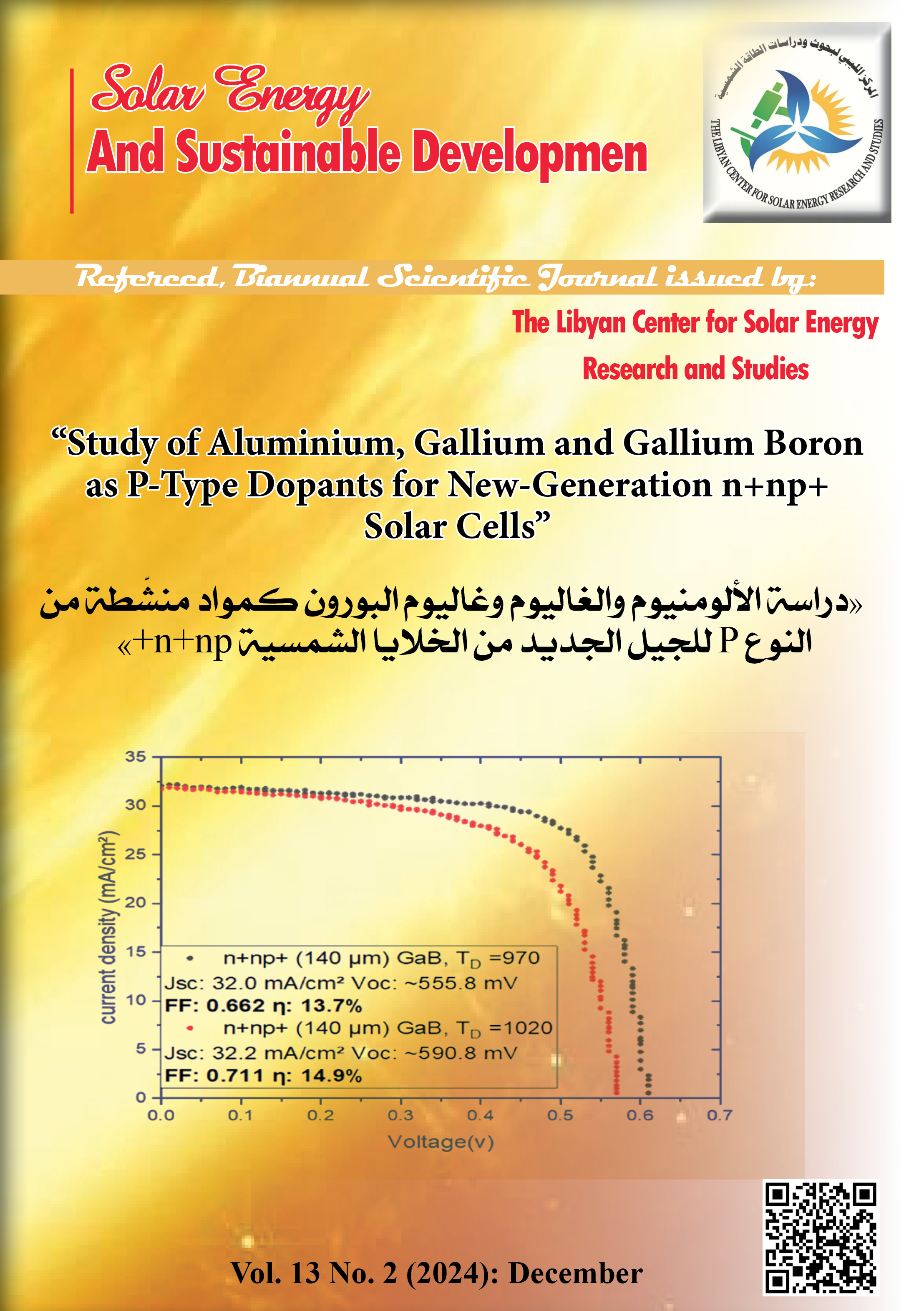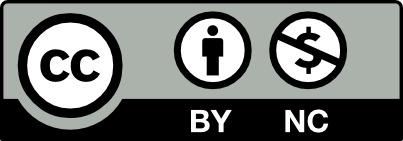Study of Aluminium, Gallium and Gallium Boron as P-Type Dopants for New-Generation n+np+ Solar Cells
DOI:
https://doi.org/10.51646/jsesd.v13i2.195Keywords:
n np silicon solar cells, gallium doping, boron doping, co-doping, surface passivation.Abstract
Silicon n-type n+np+ solar cells offer many advantages over conventional n+pp+ cells, including better resistance to light-induced degradation and higher conversion efficiency potential. However, the formation of the p+ emitter in n+np+ cells requires high diffusion temperatures and the use of alternative boron dopants is necessary to overcome the limitations of conventional processes. This study explored aluminium, gallium and gallium/boron co-doping as p-type dopants for the fabrication of thin (140 µm) n+np+ solar cells. The results showed that aluminium is not suitable for the formation of the p+ emitter due to its low solid solubility in silicon and its high segregation towards silicon oxide. Gallium required high diffusion temperatures and suffered from a degradation of the concentration profile in later stages of the manufacturing process, leading to poor performing solar cells. Gallium/boron co-doping has proved to be a promising alternative to boron. Thin n+np+ solar cells doped with GaB achieved a maximum conversion efficiency of 13.7%, slightly lower than that of boron-doped cells (14.9%). Optimisation of the GaB diffusion process and surface passivation could further improve the performance of these cells. This study demonstrates the potential of gallium/boron co-doping for the manufacture of new-generation thin n+np+ solar cells. Further research is needed to fully exploit the advantages of this technology and contribute to improving the efficiency and cost of silicon solar cells.
Downloads
Metrics
References
A. Alatrash, et al., ''Assessing the Viability of Solar and Wind Energy Technologies in Semi-Arid and Arid Regions: A Case Study of Libya’s Climatic Conditions.'' Applied Solar Energy, vol. 80. no. 1. pp. 149–170, 2024. https://doi.org/10.3103/S0003701X24600218 DOI: https://doi.org/10.3103/S0003701X24600218
K. Bakouri, et al., ''Learning lessons from Murzuq-Libya meteorological station: Evaluation criteria and improvement recommendations.'' Solar Energy and Sustainable Development Journal, vol.12, no.1, pp. 30–48. 2023. https://doi.org/10.51646/jsesd.v12i1.149 DOI: https://doi.org/10.51646/jsesd.v12i1.149
H. Korichi, A. Boucheham, A. Bensdira, and M. Kazerane, ''Advancements in Passivation and Metallization Techniques for n-Type Monocrystalline Silicon Solar Cells.'' Solar Energy and Sustainable Development Journal, vol.13, no.2, pp. 151–173. 2024. https://doi.org/10.51646/jsesd.v13i2.185 DOI: https://doi.org/10.51646/jsesd.v13i2.185
M. A. Green, ''Silicon solar cells: Evolution, high-efficiency design and efficiency enhancements,'' Solar Energy, vol. 208, p. 118165, 2023, https://doi.org/10.1016/j.solener.2020.118165.
A. S. Kagilik, A. M. Tawel, ''Performance Analysis of 14 MW Grid-Connected Photovoltaic System'' Solar Energy And Sustainable Development Journal, 4(1), 11–21. https://doi.org/10.51646/jsesd.v4i1.78. DOI: https://doi.org/10.51646/jsesd.v4i1.78
R. Schuh, M. Holm et R. Brendel, ''Origin and impact of process-induced defects in n-type silicon », Physica Status Solidi (RRL).'' Rapid Research Letters, vol. 8, no,1, p. 133–147, 2014, https://doi.org/10.1002/pssr.201308366.
H. Cheng et al., ''Emitter formation with boron diffusion from PECVD deposited boron-doped silicon oxide for high-efficiency TOPCon solar cells,'' Solar Energy Materials and.Solar Cells, vol. 240, p. 111713, 2022, https://doi.org/10.1016/J.SOLMAT.2022.111713. DOI: https://doi.org/10.1016/j.solmat.2022.111713
Q. Wang, et al.,''Boron tube diffusion process parameters for high-efficiency n-TOPCon solar cells with selective boron emitters.'' Solar Energy Materials and Solar Cells, vol. 253, p. 112231, 2023, https://doi.org/10.1016/j.solmat.2023.112231 . DOI: https://doi.org/10.1016/j.solmat.2023.112231
N. E. Grant et al., “Gallium-Doped Silicon for High-Efficiency Commercial Passivated Emitter and Rear Solar Cells,” vol. 2000754, pp. 1–8, 2021, doi: 10.1002/solr.202000754.
J. Hwang, P. Ho, J. Lewis, and R. Campbell, ''Grain boundary diffusion of aluminum in polycrystalline silicon films,'' J. Appl. Phys., vol. 51, no 3, p. 1576–1581, 2008, https://doi.org/110.1063/1.327811. DOI: https://doi.org/10.1063/1.327811
''Grain boundary diffusion of aluminum in polycrystalline silicon films for Journal of Applied Physics - IBM Research'', [Enligne]. Disponible sur: https://research.ibm.com/publications/grain-boundary-diffusion-of-aluminum-in-polycrystalline-silicon-films.
N. Grant, T. Trupke, J. Weber, and K. McIntosh, ''Gallium-doped silicon for high-efficiency commercial passivated emitter and rear solar cells,'' Progress in Photovoltaics Research and Applications, vol. 23, no 12, p. 1904–1914, 2015, https://doi.org/10.1002/solr.202000754. DOI: https://doi.org/10.1002/solr.202000754
L. Shao, J. Liu, Q. Y. Chen, and W. K. Chu, ''Boron diffusion in silicon: The anomalies and control by point defect engineering,'' Materials Science and Engineering: R: Reports, vol. 42, no. 3‑4, 2003, https://doi.org/10.1016/j.mser.2003.08.002. DOI: https://doi.org/10.1016/j.mser.2003.08.002
A. El Amrani, A. Boucheham, A. Guendouzi, B. Labdelli, C. Nasraoui, R. Si-Kaddour, ''Co-Diffusion Processing of p+/n/n+ Structure for n-Type Silicon Solar Cells Using Boron Doped Paper Sheets'', Silicon, vol. 14, no. 1, p. 223–228, 2022, https://doi.org/10.1007/s12. DOI: https://doi.org/10.1007/s12633-020-00809-3
A. Boucheham, A. Elamrani, H. Timlelt, C. Nasraoui et A. Saibi, « Investigation of p+ emitter formation for n-type silicon solar cells application », Materials Research Express, vol. 6, no. 12, p. 125905, 2019, https://doi.org/10.1088/2053-1591/ab5a0c.”. DOI: https://doi.org/10.1088/2053-1591/ab582e
P. Pal, V. Swarnalatha, A. V. N. Rao, A. K. Pandey, H. Tanaka and K. Sato, ''High speed silicon wet anisotropic etching for applications in bulk micromachining: A review,'' Micro and Nano Systems Letters, vol. 9, no 1, p. 15, 2021, https://doi.org/10.1186/s40486-021-”. DOI: https://doi.org/10.1186/s40486-021-00129-0
J. Kim, D. Inns, K. Fogel and D. Sadana, ''Surface texturing of single-crystalline silicon solar cells using low density SiO2 films as an anisotropic etch mask,'' Solar Energy Materials and Solar Cells, vol. 94, no 12, p. 2091–2093, 2010, https://doi.org/10.1016/j.solmat.2010.06.026”. DOI: https://doi.org/10.1016/j.solmat.2010.06.026
B. Labdelli et al., ''Influence of Wafer Thickness and Screen-Printing Mesh Counts on the Al-BSF in Crystalline Silicon Solar Cells,'' J. Nano- Electron. Phys., vol. 15, no 6, p. 1–5, 2023, https://doi.org/10.21272/jnep.15(6).06027. DOI: https://doi.org/10.21272/jnep.15(6).06027
A. A. Fashina et al., “Surface texture and optical properties of crystalline silicon substrates,” J. Renew. Sustain. Energy, vol. 7, no. 6, 2015, https://doi.org/10.1063/1.4937117. DOI: https://doi.org/10.1063/1.4937117
A. El Amrani, L. Boutaleb, A. Boucheham, Y. Belkacem, and C. Nasraoui, Investigation of pre-deposition temperature effect on n+-BSF properties in co-diffusion process,” Mater. Res. Express, vol. 5, no. 1, 2018, https://doi.org/10.1088/2053-1591/aaa693. DOI: https://doi.org/10.1088/2053-1591/aaa693
M. Rauer, C. Schmiga, M. Hermle, and S. W. Glunz, “Passivation of Screen-Printed Aluminium-Alloyed Emitters for Back Junction N-Type Silicon Solar Cells,” 24th Eur. Photovolt. Sol. Energy Conf. 21-25 Sept. 2009, Hamburg, Ger. 1059, no. September, pp. 1059–1062, 2009.
L. Zhao, C.L. Zhou, H.L. Li, H.W. Diao, W.J. Wang, ''Design optimization of bifacial HIT solar cells on p-type silicon substrates by simulation,'' Solar Energy Materials and Solar Cells, vol. 92, no. 6, 2008, https://doi.org/10.1016/j.solmat.2008.01.018 DOI: https://doi.org/10.1016/j.solmat.2008.01.018
B.Swatowska, T. Stapiński, K. Drabczyk, & P. Panek, ''The role of antireflective coatings in silicon solar cells-The influence on their electrical parameters.'' Optica Applicata, vol. 41, no. 2, 487–492. 2011. https://doi.org/Optica Applicata XLI(2):487
J. Schube, Metallization of Silicon Solar Cells with Passivating Contacts. 2020. [Online]. Available: https://www.reiner-lemoine-stiftung.de/pdf/dissertationen/Dissertation-Joerg_Schube.pdf

Downloads
Published
How to Cite
Issue
Section
License
Copyright (c) 2024 Solar Energy and Sustainable Development Journal

This work is licensed under a Creative Commons Attribution-NonCommercial 4.0 International License.













